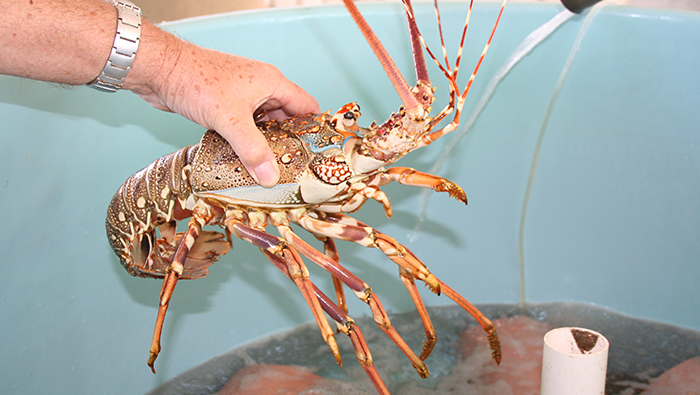
Muscat: Researchers at Sultan Qaboos University have been busy genetically profiling lobsters in a project that has earned international recognition.
There has been a dramatic decline in the numbers of scalloped Spiny Lobsters landed from the waters around Oman in recent years. In the 1980s the annual catch was around 2000 tons but in 2016 that figure dropped to just 450 tons.
Oman is the largest seafood supplier in the Gulf and in 2016 the sector raked in some OMR240million.
Researchers investigated the decline by profiling the lobsters.
A spokesman for the university said: "The government of the Sultanate of Oman in its ninth Five-Year National Development Plan (2016-2020) has identified fisheries as a key sector for contributing to the country’s gross domestic product (GDP). In support of future fishery- and aquaculture-development in Oman, the Ministry of Agriculture and Fisheries Wealth (MoAFW) has conducted extensive surveys of potential sites, developed a comprehensive guide to better management practices for Oman fisheries and aquaculture, and developed a national strategic plan.
"With about 3100 km of coastline providing a home to more than 900 species of fish and crustaceans, the sultanate has long been the largest seafood supplier in the Gulf. The landing was around 280,000 tons in 2016, valued at more than 240 million Omani rials (R.O.). Ensuring a sustainable and long-term viable fishery of marine species will contribute to creating diversity in economy, in addition to generating wealth and foreign currency earnings via exports and increases in gross domestic product and employment. All these objectives are in line with the national ambitions of the government of Oman and will be of long-term benefit to its citizens.
"In Oman, the major commercial species, the scalloped spiny lobster, Panulirus homarus (P. homarus), inhabits the Arabian Sea coast between Ras Al-Hadd and Dalkut. It is a reef dwelling species, most abundant on coral and coastal fringing rocky reefs and the areas surrounding these. Spiny lobster fisheries have a long tradition in Oman and are currently experiencing a long-term decline in catch. The annual harvest of Omani lobsters has declined dramatically from 2000 tons in the 1980s to only about 485 tons in 2016. By contrast, the gross unit revenue from lobster fishery has increased from around 3000 R.O. per ton in the 1980s to more than 5000 R.O. per ton in 2016.
This has accelerated the high demand for lobster and contributes to the current over exploitation that lobster fishery is experiencing. To counteract this breakdown, Oman’s fishery managers have announced targeted regulations and recommendations that are primarily based on data from growth, mortality and catch. However, to achieve comprehensive fishery management guidelines for the species, a wide range of biological aspects, including demographic interactions of individuals and genetic structuring of the whole population, should be considered. This will contribute to understand variations within and between lobster stocks, and will enable ministry officials to introduce regional management and improve possible discrete stocks."
In a project funded by the Research Council of Oman (TRC), scientists at the Center of Excellence in Marine Biotechnology (CEMB) at Sultan Qaboos University (SQU) have used state-of-the-art genetic tools to examine population structures of spiny lobster along the entire coastline of Oman. The project is led by Dr. Madjid Delghandi, Senior Scientist, at the Center of Excellence in Marine Biotechnology.
The spokesman added: "This work is unique and describes a collaborative effort between domestic scientists from the CEMB, the MoAFW, and the College of Agriculture and Marine Science at SQU, along with international collaborators from Australia and South Africa. The generated knowledge will strongly contribute to sustainable fishery management and subsequently protect spiny lobster stock in Oman. It also supports future activities related to commercial aquaculture developments of this species in Oman and in other tropical regions.
"The results from this study indicate the presence of two major stocks of scalloped spiny lobster in Oman, one consisting of stock from Al-Sharqiyah and Al-Wusta governorates, while the second one includes spiny lobsters from Dhofar. Findings support the idea of regional fishery management measures for these genetically different stocks."
During this research project, one PhD and three Omani MSc students were educated and training has been given to three other graduate students. The results of the project have received awards in an international conference in South Africa. Findings from the project have been published in seven scientific manuscripts in international journals with high impact factors.
The other members of the team involved in this project are Rufaida Al Breiki, PhD student, Abdul-Aziz Said Al-Marzouqi, General Director of Fisheries Development, Ministry of Agriculture & Fisheries, Dr. Hussein Samh Al-Masroori, Assistant Professor, Department of Marine Science & Fisheries, and Mohammed Al Abri, Assistant Professor, Department of Animal and Veterinary Sciences College of Agriculture and Marine Sciences, SQU.